Last week I took Bertha’s head off and took it to the machine shop. Two bad valves were found, which might explain the rough running that caused my friend Alex to sideline the car after it was stolen and recovered 26 years ago; it certainly explains why the car ran so poorly when I got it running a few weeks ago—just well enough to pull it out of the inaccessible garage where it had been sitting since 1992.
So, while waiting for the machine shop to service the head, I clocked through the first layer of an onion-like punch list of repairs.
I need to draw a distinction between what I did with Louie, the ’72 2002tii that hadn’t run in a decade that’s the subject my book Ran When Parked, and what I’m trying to do with Bertha. In Ran When Parked, I describe resurrecting Louie in a dramatic one-week period, a thousand miles from home, while sleeping in borrowed bedrooms, using tools and parts that I’d brought with me, and doing everything to avoid ordering any additional parts unless absolutely necessary because of the several-day delay that that would introduce.
Because of the unnaturally compressed time frame of the Louie adventure, I was absolutely merciless about which things needed to function (fuel-delivery system, cooling system, brakes) and which didn’t (heat, handbrake, exhaust, a windshield that sealed in the rain). In contrast, Bertha was now sitting, conveniently, in my own garage at my house. While that meant that the time frame for both repairs and parts orders could be much more reasonable, I dove into Bertha with a ferocity that was anything but leisurely.
As I explain in Ran When Parked, even if a long-dead car has no engine problems, any car that sits for a decade or more typically has systemic issues with the fuel-delivery system (dead or dying fuel pump, rust in the tank and fuel lines) and the brake and clutch hydraulics (seized or leaking master and slave cylinders and calipers, plugged flexible rubber lines). I’d given the gas tank a cleaning and replaced all the fuel lines and filters before I got Bertha running just well enough to flee her 26-year tomb and drive up to the street, but the brakes were only barely functional.
Bertha has a full tii braking system—struts, calipers, rotors, master cylinder, booster, and wheel cylinders—that I’d pulled from a car I parted out long ago. For a time, tii rotors and calipers had been very pricey, but these days, rebuilt calipers are available for about $35 each from Cardone, and the rotors are about $30 each from RockAuto. New rear drums (I hate that they’re pricier than the rotors), wheel cylinders, and shoes were also sourced from RockAuto. I already had a set of braided stainless flexible hoses that I used to replace the ancient, hardened, and almost certainly plugged-up rubber lines.
The total cost of these braking components was about $350. Of course, it’s also possible that the master cylinder itself has gone bad from sitting for 26 years, but my plan is to get the car running, see how the brakes perform, and change the master only if necessary.

New front caliper and rotor. Yum.

Old (top) and new (bottom) flexible brake lines.
The only drama with doing the brakes was that in my haste, I accidentally stripped one of the 6-mm Allen-head screws holding the rotor to the hub; I hadn’t properly cleaned out the bolt hole and tapped the Allen head socket into it to fully seat it before squeezing the trigger on the impact wrench. I took some 0.003″ shim material, made a cylindrical shim, put it in the Allen hole to take up slack, tapped the Allen socket in with a hammer, and out came the bolt. This technique will forever be part of my arsenal.
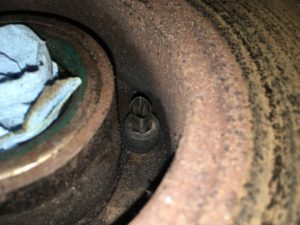
0.003″ shim stock inserted into the stripped hole to seat the Allen bit.

The successfully-extracted stripped Allen bolt.
Unlike the brake hydraulics, Bertha’s clutch hydraulics appeared to be functional. However, the fact that Louie’s clutch master cylinder seemed to work fine last year but then failed at Mile One of the drive home, just before the entrance ramp to the highway, flashed like a bright red warning sign, so I ordered a new clutch master and slave and will likely change them after I get the car up and running.

The frozen shift linkage.
When I was still working in Alex’s neighbor’s garage, I’d gotten Bertha’s seized shift linkage freed up sufficiently to persuade it, with the aid of a pipe over the shift lever, to go between neutral and first, but it clearly needed to be properly unseized. I pulled out the linkage and grinned when I saw that it was a vintage Metric Mechanic setup with bronze shift bushings that I’d installed 30 years ago. Using heat, penetrating oil, and brute force, I got the pieces separated. I then cleaned up the galled surfaces with emery cloth. After re-installing everything, it shifted so smoothly and tightly that I nearly wept.
I had unbolted the front of the driveshaft in order to access the shift linkage. The giubo came out in pieces, which is no surprise on a long-dormant car. With the front of the shaft lowered, I unbolted the intact-looking center support bearing (CSB), gave it a spin, and found it to be very tight. I worked it with Silikroil penetrating oil and it freed up, but I imagined it whining as soon as I got the car up to speed. What the hell, halfway there, right? I unbolted the back of the driveshaft, separated the two halves, and replaced the CSB. The driveshaft, along with a new old stock Goetz giubo I had kicking around, went back in the car.
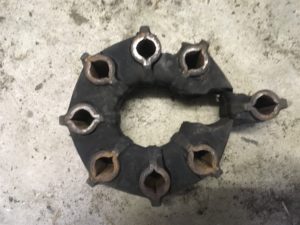
The giubo was, um, interesting.
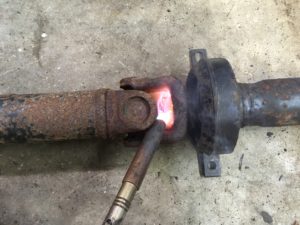
Loosening the driveshaft nut to replace the CSB.
Last week, I mentioned that I accidentally destroyed Bertha’s original Headercraft headers while removing them, and that at least for the short term, I planned to replace them with a conventional exhaust manifold and downpipe. A Facebook friend, Kyle Duquette, sent me an exhaust manifold and a few other parts. I almost ordered three new exhaust pieces—headpipe, resonator, and muffler—for an Ansa standard exhaust, as they’re relatively inexpensive and I’ve been pleased with them when I’ve used them on other cars, most recently Louie. But I found that in the Siegel Ancestral Parts Heap, I had what appeared to be not only a good headpipe, but, incredibly, a good Ansa muffler for a ’75 2002 like Bertha with the center-exiting tailpipe.
There’s always risk in replacing only isolated exhaust pieces; the better advice is always, “Replace it all.” But I’m trying to resurrect Bertha on a shoestring budget, so I ordered only the new resonator and tried to use the old muffler and headpipe from my parts heap.
However, I found that, as is often the case with used mufflers, the clamp that attaches the muffler to the resonator had squeezed an indented ridge into the inlet pipe of the muffler, preventing it from sliding over the end of the new resonator. I bought a $16 tailpipe stretcher from Harbor Freight to internally press out the ridge caused by the clamp. The results were far from a slam-dunk, but after repeated use of the stretcher, combined with a little grinding with the Dremel tool, I knocked down the internal clamp-created ridge enough that the old muffler slid over the end of the new resonator. I installed the muffler and left the manifold, headpipe, and resonator for when I have the head back.
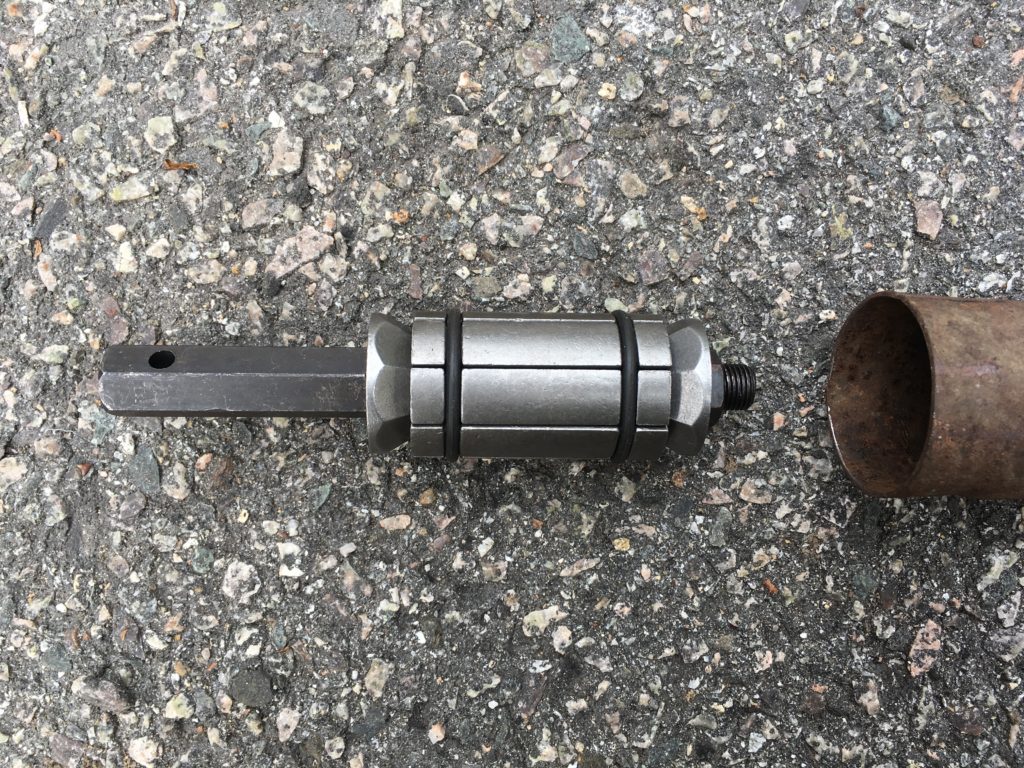
Yes, there IS such a thing as a hole-stretcher. It’s next to the blinker fluid, the muffler bearings, and the metric adjustable wrenches.
Part of the theft damage that had occurred to Bertha 26 years ago included a shattered passenger-side window. If you’ve ever had broken glassin a car, you know that you find the little square fragments of safety glass everywhere for the life of the car. I gave the interior the most thorough vacuuming known to man to get rid of as many of the glass cubes and as much of the remaining topical rodent detritus as I could, then replaced the window.

Glass shards at the bottom of the door.
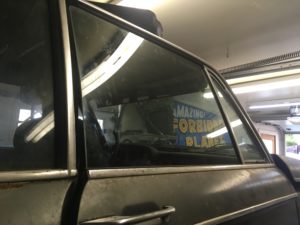
The replaced passenger-side window.
With the new door glass in, I took the opportunity to clean all the windows in the car, inside and out. On a car that’s been sitting for decades, clean glass can have a transformative effect. It’s like washing off the dust of the tomb. I thought of Uma Thurman in Kill Bill Part II taking a shower after being buried alive. The outside surfaces of Bertha’s windows had such a film on them that I literally scraped every inch with a single-edged razor blade before using the Windex. But the effect was stunning. The car went from this:
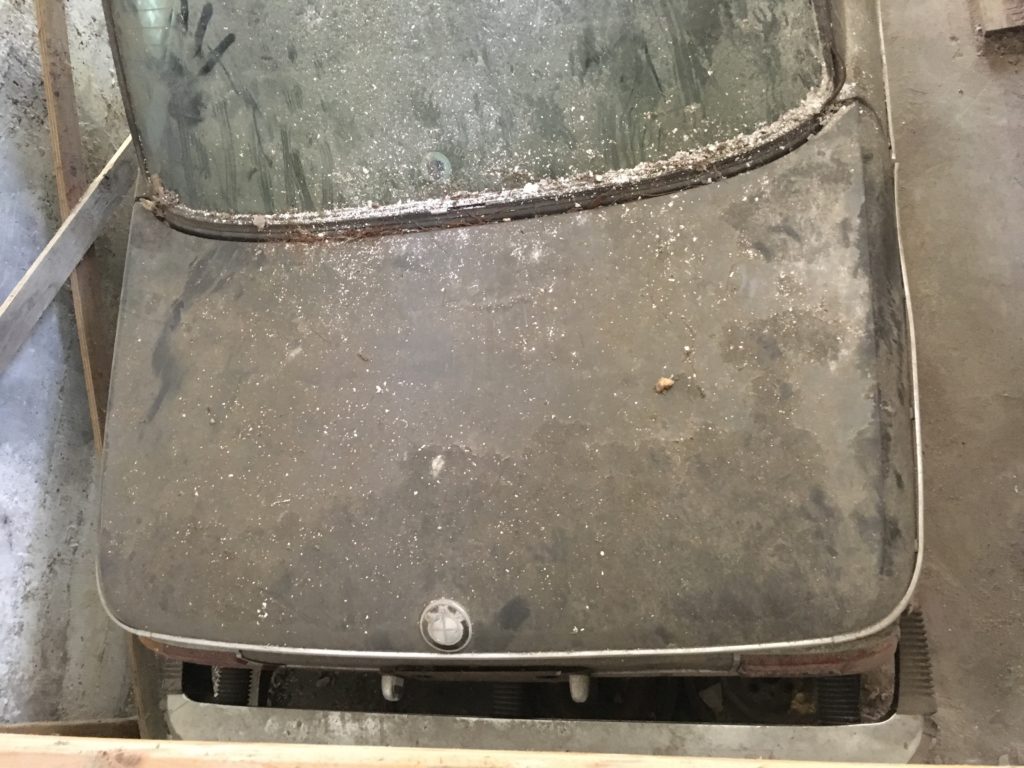
Decades of grime before cleaning.
To this:
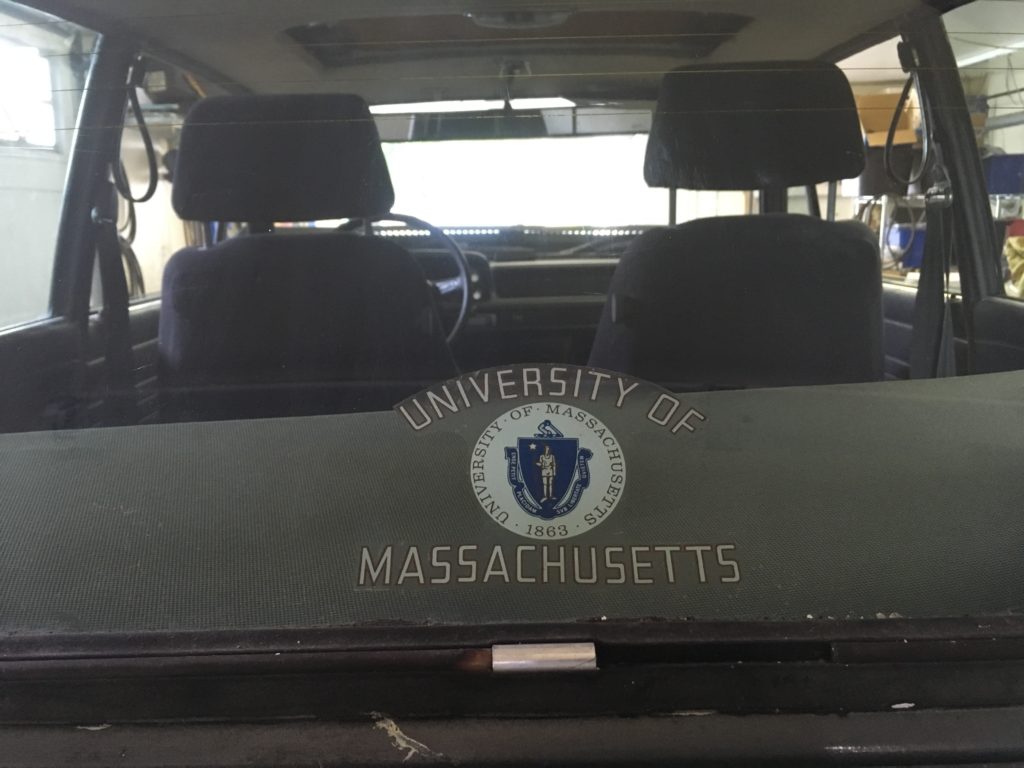
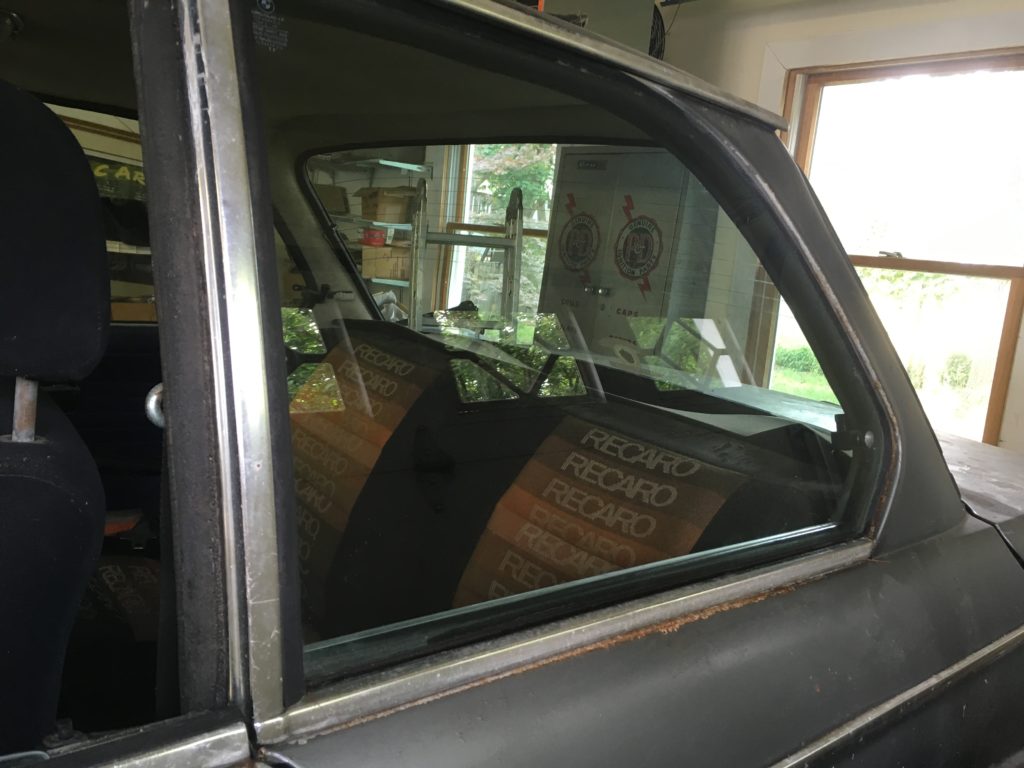
Nothing like clean windows to make a car feel cared for.
A bonus of the thorough vacuuming of the interior was that I found the lenses for the Cibié Oscar driving lights; for some reason, they were hidden away under the seats. Although the lenses were cracked and the bulbs were non-functional, I installed them into the empty headlight buckets that had been adorning Bertha’s bumper, looking like errant vertical cereal bowls in search of some cosmic purpose. I took the spare headlight that Kyle Duquette had sent me along with one that I had kicking around, and suddenly, for the first time in decades, Bertha had a face.

The face of Bertha returns.
At this moment, Maire Anne came into the garage. “What are you doing?” she asked.
“Giving Bertha a face.”
“Are those the Cibié Oscars?”
It was an odd question; I do assume that my wife listens to me as I blather on endlessly about which parts I installed today, but I didn’t expect her to correctly identify just-installed 30-year-old driving lights. “The ones on the bumpers? Yes, those are the Oscars.”
“You need to come inside right now, and come up to the third floor with me,” she said. I swear I am not making this up. What, I thought, I’ve been with this woman for 40 years, and only now do I learn that Cibié Oscars are what makes her hot?!
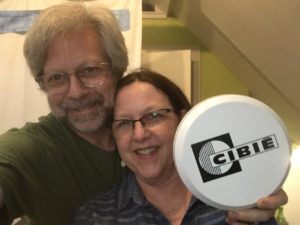
Me, my wife, and a mint vintage Cibié Oscar, an unsolicited gift from CCA member Alan Hunter Johannson.
We went up to the third floor, and Maire Anne handed me a box. “This,” she said, “is from Alan Hunter Johannson.”
Alan is a BMW CCA member who lives in Winston-Salem whom I’d met only once, quite briefly, but have become quite close with on Facebook. I opened up the box.
In it was a pair of mint vintage Cibié Oscars.
Maire Anne then recounted to me the series of messages that had passed between her and Alan. The lights, I learned, had come from Alan’s vintage Volvo. He wanted to send her the lights and have the present come from her, but she insisted that it be his present. He agreed, but recommended that she give me the box when I was having a particularly bad day and things had gone horribly wrong; her hand had been forced when she saw that I had just installed the old Cibiés.
I immediately sent the above picture to Alan, thanked him profusely, and explained that I’d likely install his generous present when I do the bumper swap, and that at that point, the lights will certainly be the best-looking component on Bertha.
So, as you can see, quite a lot has come together—but I am still waiting on the head. Once I install it, a fair amount of sorting and tweaking will be necessary. The odds of driving Bertha to Oktoberfest in Pittsburgh, as people have been egging me on to do (*cough* Wegweiser *cough*), are slim (slim to none is probably more accurate). But we do live in a Hack Mechanic universe, where I like to think that all things are as possible as unbidden mint vintage Cibié Oscar driving lights being presented to you, with a hint of salaciousness, by your wife, sent by a CCA member and Facebook friend you met only once.
I love this club.—Rob Siegel
Rob’s new book, Just Needs a Recharge: The Hack MechanicTM Guide to Vintage Air Conditioning, is available here on Amazon. His previous book Ran When Parked is available here. Or you can order personally inscribed copies of all of his books through Rob’s website: www.robsiegel.com.





















